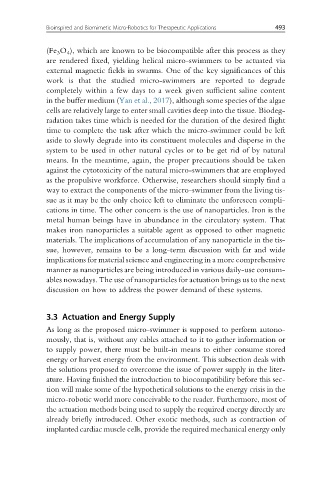Page 499 - Handbook of Biomechatronics
P. 499
Bioinspired and Biomimetic Micro-Robotics for Therapeutic Applications 493
(Fe 3 O 4 ), whichareknowntobebiocompatible afterthisprocessasthey
are rendered fixed, yielding helical micro-swimmers to be actuated via
external magnetic fields in swarms. One of the key significances of this
work is that the studied micro-swimmers are reported to degrade
completely within a few days to a week given sufficient saline content
in the buffer medium (Yan et al., 2017), although some species of the algae
cells are relatively large to enter small cavities deep into the tissue. Biodeg-
radation takes time which is needed for the duration of the desired flight
time to complete the task after which the micro-swimmer could be left
aside to slowly degrade into its constituent molecules and disperse in the
system to be used in other natural cycles or to be get rid of by natural
means. In the meantime, again, the proper precautions should be taken
against the cytotoxicity of the natural micro-swimmers that are employed
as the propulsive workforce. Otherwise, researchers should simply find a
way to extract the components of the micro-swimmer from the living tis-
sue as it may be the only choice left to eliminate the unforeseen compli-
cations in time. The other concern is the use of nanoparticles. Iron is the
metal human beings have in abundance in the circulatory system. That
makes iron nanoparticles a suitable agent as opposed to other magnetic
materials. The implications of accumulation of any nanoparticle in the tis-
sue, however, remains to be a long-term discussion with far and wide
implications for material science and engineering in a more comprehensive
manner as nanoparticles are being introduced in various daily-use consum-
ables nowadays. The use of nanoparticles for actuation brings us to the next
discussion on how to address the power demand of these systems.
3.3 Actuation and Energy Supply
As long as the proposed micro-swimmer is supposed to perform autono-
mously, that is, without any cables attached to it to gather information or
to supply power, there must be built-in means to either consume stored
energy or harvest energy from the environment. This subsection deals with
the solutions proposed to overcome the issue of power supply in the liter-
ature. Having finished the introduction to biocompatibility before this sec-
tion will make some of the hypothetical solutions to the energy crisis in the
micro-robotic world more conceivable to the reader. Furthermore, most of
the actuation methods being used to supply the required energy directly are
already briefly introduced. Other exotic methods, such as contraction of
implanted cardiac muscle cells, provide the required mechanical energy only

